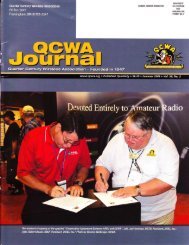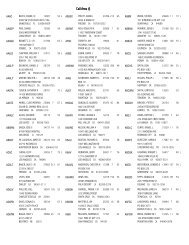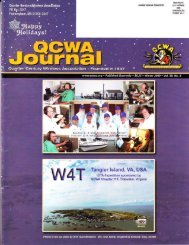G[mloulnal - Quarter Century Wireless Association
G[mloulnal - Quarter Century Wireless Association
G[mloulnal - Quarter Century Wireless Association
You also want an ePaper? Increase the reach of your titles
YUMPU automatically turns print PDFs into web optimized ePapers that Google loves.
y Keith Pugh, W5!U/VK6BRB, Vice president, Operations, AMSAT-NA,<br />
3525 Winifred Dr., Ft. Worth, TX 761J3<br />
Phase 3D/AO-40 Launch and lnitial Operations plus<br />
Amateur Radio on the lnternational Space Station<br />
INTRODUCTION .<br />
Since the last issue of this column appeared in print, phase<br />
3D has been placed in orbit and re-named AMSAIbSCAR 40<br />
(AO-40). It has suffered a "rocky" start but is now on the road<br />
to becoming a useful "Bird." Also, the International Space Station<br />
has now seen its first long term crew, Expedition 1, come<br />
and go. The Expedition 2 crew is now in place and activiry is<br />
picking up. With these milestones accomplished, the Amaieur<br />
Radio on the International Space Station (ARISS) project is<br />
underway.<br />
AMSAT OSCAR 40 -<br />
Launch - After the completion of a long launch campaign,<br />
Phase 3D was launched by an Ariane 5 launcher, along *ith<br />
three other payloads, on November 16,2000. The launch was<br />
a "textbook perfect" launch, on schedule, with the primary payload<br />
separated first, two other secondary payloads rr.rt, "nj finally,<br />
Phase 3D became AO-40 as it left the launch vehicle.<br />
Live launch coverage was provided by Arianespace from Kourou,<br />
French Guiana, via a TVRO satellite and via the Internet. The<br />
Kourou Radio Club also provided launch coverage via their club<br />
station on 20 meters. Vithin North Americar coverage was<br />
provided via the AMSAT Launch Information Net Service<br />
(ALINS). This author had the pleasure of coordinating the<br />
ALINS for this launch. A brief description of this activiryis in<br />
order.<br />
The basis of the ALINS activity was a Teleconference Bridge<br />
provided by Nick Pugh, K5QXJ, in Lafayette. LA. Without<br />
Nick's generous donation of the Bridge, none of the following<br />
would have been possible. First, Harold Reasoner, K5SXK,<br />
provided the down link from the TVRO satellite in his living<br />
room along with a connection into the Teleconference Bridge<br />
and a feed to a wide area 2 meter repeater in Fort Worth, TX. I<br />
provided the real rime commentary from the TVRO feed into<br />
the Bridge from Harold's house. Other commenrarors on rhe<br />
Bridge were: Robin Haighton, VE3FRH, President of AMSAI-<br />
NA; Bill Tynan, W3XO, AMSALNA Chairman of the Board;<br />
Stacey Mills, W4SM, North American Command Station Operator;<br />
Chuck Green, N0ADI, Second-in-Command of the<br />
Launch Gam; Jim White, \7D0E, RUDAK Coordinator; and<br />
Andy Mac Allister, W5ACM, AMSAI Board Member.<br />
Outlets from the Bridge were: Goddard Space Flight Center<br />
ARC,'WA3NAN, coverage on 3.860, 7.185, 14.295,21.350<br />
MHz, and 2 merer coverage in the .Washington, D.C., area; Jet<br />
Propulsion LaboratoryARC, \f6\,IO, .orr.i"ge on 7.188 MHz<br />
10 QCWA fournal - Summer 2001<br />
and 2 meter coverage in the Los Angeles area; Houston AMSAI<br />
Net, W5ACM/KK5DO, ryRO feed to participating individuals<br />
and repearers throughout North Ameiica and Houston, TX,<br />
area coverage on 2 merers; Lanny Priddy, K5LB 3.840 MHz<br />
transmission from Fort tVorth, TX; Art Serrano, KB5OAG,<br />
14.282 MHz transmission from Corpus Chrisd, TX; and Dick<br />
Raitt, WA5VKS, 7.179 MHz transmission from plano, TX.<br />
ALINS coverage started about fifteen minutes before iaunch<br />
and lasted until all payloads were safely separated and some of<br />
the post launch celebration in Kouror., *", o,r.r. Total time was<br />
about 1.5 hours. These ourlers provided coverage of most of<br />
North America. There were a few isolated "holes'i in the coverage,<br />
but overall it went very well.<br />
Post Launch Activity - After the successful launch, all ears<br />
were tuned to the 70 cm Middle Beacon frequency for first<br />
reception reporrs. The beacon was scheduled to be activated<br />
automatically about three hours after launch. Based on orbital<br />
predictions, the Command Stations in Australia and New<br />
Zealand would have "first shot" at hearing the signals. \W{hen<br />
these stations did not hear the signals on ichedule, a new program<br />
was uploaded ro acrivate the 2 meter Beacon. This command<br />
worked and the anxious world was able to hear the familiar<br />
400 baud PSK telemetry at last. This failure of the 70 cm<br />
beacon was the first indication of any trouble on board AO-40.<br />
The Command Stations immediately set about assessing<br />
the "health and weifare" of our new "Bird." These first dap<br />
saw an explosion in activity listening to and decoding rhe new<br />
telemetry. New 400 baud PSK demodulators based on Sound<br />
Card tchnology were invented and live telemetry was made<br />
available via the Internet. The satellite's spin rate and attitude<br />
were adjusted in preparation for the first "burn" of the 400<br />
Newton kick motor. During this time, everything appeared to<br />
be "Rosy." By 11 December, everything was ready foi the first<br />
"burn."<br />
The first indication of difficulties was failure to pressurize<br />
the system with Helium on the firsr command. Subsequent<br />
commands finally succeeded and the "burn" was accompliihed;<br />
however, the motor failed to shut down ar the proper time. An<br />
additional three minutes of "burn" produced an Apogee of<br />
60,000 kilometers instead of the planned 50,000. Two days<br />
later, 13 December, while investigating the "1ong burn," the 2<br />
meter beacon went dead. This produced real concern about the<br />
health of the new satellite. Initiaily, it was a waiting game while<br />
pre-programmed timers and resers did their intended work.<br />
Nothing happened and the concern grew The first positive<br />
action occurred a few days before Chrisrmas when NORAD<br />
succeeded in locating AO-40 with RADAR after being given



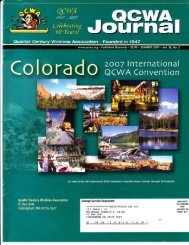
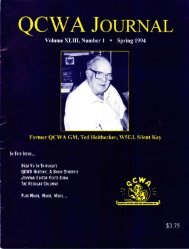
![11{J hI EfifSIt]E I]E - Quarter Century Wireless Association](https://img.yumpu.com/11816560/1/190x245/11j-hi-efifsite-ie-quarter-century-wireless-association.jpg?quality=85)
